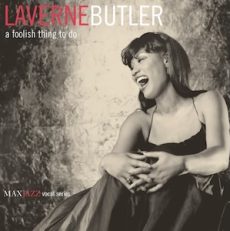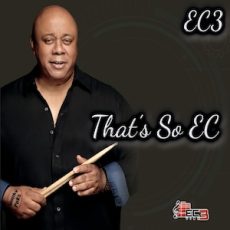
Daily Dose Of Jazz…
Clarence Lacquese Penn born on March 2, 1968 in Detroit, Michigan and started playing the drums at around eigh years old. In 1986, while still at high school, he attended the Interlochen Arts Academy. He started studying at the University of Miami in Florida that same year, but transferred to Virginia Commonwealth University.
At Virginia Commonwealth he studied with Ellis Marsalis, and played in the pianist’s trio from 1987 to 1991, including for a tour of Japan in 1990. Penn graduated in classical percussion in 1991 and was part of vocalist Betty Carter’s trio from until 1993.
Penn later went on to work with David Sanchez, Jimmy Smith, Slide Hampton, Jimmy Scott, Greg Hatza, Stanley Clarke, Tim Warfield, Bob Berg, Diana Krall, Cyrus Chestnut, and Stephen Scott.
He recorded his debut album, Penn’s Landing, for Criss Cross Jazz in 1997 with some of the tracks he composed. His sophomore album as leader, Play-Penn, was recorded four years later, followed by a third the following year. He took a nine year hiatus from recording then recorded three more albums.
Drummer Clarence Penn, who also plays organ and rhodes, continues to perform and record.
More Posts: bandleader,drums,history,instrumental,jazz,music,organ,rhodes

Daily Dose Of Jazz…
LaVerne Butler was born on February 25, 1962 in Shreveport, Louisiana. The daughter of saxophonist Scott Butler, she was extensively exposed to jazz and rhythm and blues music and with a lot of encouragement from her father.
Leaving Shreveport for New Orleans, Louisiana she attended the University of New Orleans. During this period LaVerne became a fixture in the city’s Dixieland and bebop venues singing with Ellis Marsalis, Alvin Batiste, Henry Butler ( no relation) and James Black, among others. A move to New York City in 1984 had her working as an English teacher, singing in clubs and studying with jazz veteran Jon Hendricks.
Her musical influences were Nancy Wilson and Sarah Vaughan. In 1992 she recorded her debut album No Looking Back for Chesky Records. Her sophomore album for the label was Day Dreamin’ , then planned on signing with Herbie Mann’s Kokopelli label in 1997, but that fell through when the company experienced financial problems. She then was brought into the MaxJazz label for two albums and finally landed with HighNote Records for her 2012 release Love Lost and Found Again.
Vocalist LaVerne Butler, who has yet to receive the recognition her talent deserves, continues to perform around the country.
More Posts: bandleader,history,instrumental,jazz,music,vocal

Daily Dose Of Jazz…
Mark Gross was born February 20, 1966 in Baltimore, Maryland and grew up listening to gospel in his childhood home. His interests in classical music led him to the Baltimore School for the Arts, then studied one semester at Howard University. He matriculated four years at Berklee College of Music, earning a Bachelor of Arts Degree in Music Performance and upon graduation in 1988, Gross began his professional music career in jazz.
Gross has toured the world with the Mark Gross Quartet, Buster Williams, Philip Harper, Nat Adderley, Dave Holland, Mulgrew Miller, Nicholas Payton, Delfeayo Marsalis, Wynton Marsalis, Dizzy Gillespie, Nancy Wilson, Jimmy Heath, Dizzy Gillespie Alumni Big Band, Village Vanguard Jazz Orchestra, Tom Harrell Big Band, Duke Ellington Orchestra, Cyrus Chestnut, Regina Carter, Stephon Harris, Walter Booker, Jimmy Cobb, Don Braden, Lenora Zenzalai Helm, among others.
He has performed several times on Broadway including Five Guys Named Moe, Shuffle Along and Ain’t Too Proud: The Life and Times of The Temptations. Mark first recorded as a solo act in 1997 with Preach Daddy, followed by his sophomore project in 2000 The Riddle of the Sphinx. In 2013 he recorded Blackside, Mark Gross + Strings five years later and the soon to be released The Gospel According to Mark: A Jazz Suite this year.
Alto saxophonist Mark Gross, who plays in the hard bop tradition, continues to perform, compose and tour.
More Posts: bandleader,history,instrumental,jazz,music,saxophone

Requisites
Please Send Me Someone To Love ~ Phineas Newborn Jr. | By Eddie Carter
Phineas Newborn Jr. was an exceptional pianist and one of my favorite musicians growing up. The first album I encountered by him as a teenager is this morning’s selection from the library. Please Send Me Someone To Love (Contemporary Records S7622) hit the stores in 1969 and is an excellent trio album. It was his fourth release for Lester Koenig’s label and is a companion to Harlem Blues, released six years later in 1975. Both albums were recorded during the same sessions, with the superb rhythm section of Ray Brown on bass and Elvin Jones on drums. My copy is the 1969 U.S. deep groove Stereo release.
The first side opens with Percy Mayfield’s Please Send Me Someone To Love, featuring a smooth, slow-tempo melody. Phineas delivers a dreamy solo, evoking a sense of longing and comfort, resulting in one of the album’s most beautiful moments. Ray and Elvin’s gentle accompaniment leads the trio back to the theme and a quiet, reflective conclusion. Rough Ridin’, an upbeat piece by Ella Fitzgerald, Hank Jones, and Bill Tennyson follows with an energetic melody by the ensemble. Phineas showcases his joyful groove with impressive skill as the only soloist, culminating in the group’s lively finish.
Come Sunday by Duke Ellington is a beautiful ballad that starts with Phineas’ tender solo introduction and flows seamlessly into the trio’s lovely melody. The pianist shines as the centerpiece, delivering an attractive, elegant interpretation with great warmth before a soft and gentle ending. Ray’s bass steers the course into Brentwood Blues by Phineas Newborn Jr., setting the stage for the ensemble to swing effortlessly through the melody. Phineas initiates the opening statement, articulating each note and verse with clarity. Ray then takes a brief, soulful walk to the closing chorus and climax.
Side Two starts with He’s A Real Gone Guy by Nellie Lutcher. Elvin’s Latin-flavored introduction breathes life into the track briskly, setting the stage for the trio’s lively theme. Phineas takes the lead with a vigorous interpretation, and Elvin’s electrifying brushwork fuels the finale, bringing the trio’s ending theme to a dynamic close. Black Coffee by Sonny Burke and Paul Francis Webster opens with a profoundly moving piano introduction by Phineas, transitioning into an intimately soft melody. His beautiful performance is anchored by the solid foundation laid by Ray and Elvin ahead of a lovely finale.
Little Niles is a jazz waltz by Randy Weston that is a tribute to his son. The trio’s version is delightfully vibrant, with Ray and Elvin’s introduction effortlessly shifting into the melody. Phineas showcases his impeccable technique during the song’s only solo, leading smoothly to the reprise and the song’s close. Stay On It, by Count Basie and Tadd Dameron, secures a swinging makeover with Phineas’ solo introduction. The trio’s lively opening chorus follows, with Ray and Elvin providing a solid foundation, allowing Phineas to deliver a remarkable interpretation in the song’s only solo, leading to the trio’s exit.
Lester Koenig was the producer and recording engineer for Please Send Me Someone To Love. The album’s impeccable sound quality creates the illusion that the trio is performing live in your listening room. If you seek an outstanding trio album, I wholeheartedly recommend Please Send Me Someone To Love by Phineas Newborn Jr. It is an excellent addition to any jazz library, serving as a perfect introduction for new listeners to his music and a delight for seasoned collectors and fans. This album also pairs beautifully with Harlem Blues and is a must-have for any jazz enthusiast of piano trios!
~ Harlem Blues (Contemporary Records S7634) – Source: Discogs.com
~Come Sunday – Source: JazzStandards.com
~Black Coffee, Little Niles, Please Send Me Someone To Love – Source: Wikipedia.org
© 2025 by Edward Thomas Carter
More Posts: choice,classic,collectible,collector,history,instrumental,jazz,music,piano

Daily Dose Of Jazz…
Ernest “EC3 Coleman III was born a second generation musician in Naples, Italy on February 9, 1963 to Ernest and Rebecca Coleman. His father, Ernest Jr. was a jazz musician who played tenor saxophone and was a great arranger and composer.
He studied at the Naval Conservatory of Music in Norfolk, Virginia and was awarded a special honor for being the youngest student to graduate from this conservatory. Moving to Los Angeles, California after his tour with the Navy Band, EC began his true musical quest performing for Guys & Dolls, Ain’t Misbehavin, and A Chorus Line.
Getting the call to work with Loretta Holloway in Las Vegas, Nevada he opened for Jay Leno, Bill Cosby, David Brenner, Yakov Smirnoff, Whoopi Goldberg, Don Rickles and many many more. Coleman took over as Loretta’s musical director and traveled around the world. For twelve years.
He eventually got called to play with jazz bassist Al McKibbon. Excited to get the call, he auditioned and got booked for The Bourbon Street Review show. For three years this was his training ground. Al being like a second father to him, they lived together for many years and this was where he attained most of his great knowledge of music.
When the show closed Billy Higgins was there to offer EC work with saxophonist Azar Lawrence and for the next year and a half they were on the road. A move to Las Vegas, Nevada saw him working with Frank Sinatra’s pianist and conductor Vincent Falcone. Meeting jazz pianist Kevin Toney led him to play with Kevin bassist Brad Bobo.
He went on to work with Kenny Burrell, Russell Malone, Lorendo Alameida, Lorez Alexandria, John Clayton, George Cables, Herman Riley, Charlie Owens, Frank Sinatra, Vic Damone, Diahann Carroll, Pudgy, and the orchestras of Caesar Palace, Harrah’s Tahoe and Reno, and The Las Vegas Symphony.
Since then he embarked on a solo career as a leader, recording eight albums and producing thirteen records for Misha, Wendy C, Wendy B, Rayshun Lamarr, Zac Williams, Fabian, and Troy “Sol” Edler.
Drummer, producer and bandleader Ernest “EC3” Coleman continues to expand the language of his musical talent.
More Posts: bandleader,drums,history,instrumental,jazz,music,producer




